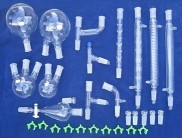
Laboratory glassware may be made from several types of glass, each with different capabilities and used for different purposes. Borosilicate glass is a type of transparent glass that is composed of boron oxide and silica, its main feature is a low coefficient of thermal expansion making it more resistant to thermal shock than most other glasses. Quartz glass can withstand very high temperatures and is transparent in certain parts of the electromagnetic spectrum. Darkened brown or amber (actinic) glass can block ultraviolet and infrared radiation. Heavy-wall glass can withstand pressurized applications. Fritted glass is finely porous glass through which gas or liquid may pass. Coated glassware is specially treated to reduce the occurrence of breakage or failure. Silanized (siliconized) glassware is specially treated to prevent organic samples from sticking to the glass.[
Scientific glass blowing, which is practiced in some larger laboratories, is a specialized field of glassblowing. Scientific glassblowing involves precisely controlling the shape and dimension of glass, repairing expensive or difficult-to-replace glassware, and fusing together various glass parts. Many parts are available fused to a length of glass tubing to create highly specialized piece of laboratory glassware.